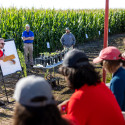A Madison Initiative status report
While the university outlines plans for the next phase of the Madison Initiative, the original investment has already taken shape across campus in a diverse range of projects.
|
Related story: Students, state focus of Madison Initiative II |
Priorities such as cross-department faculty hiring, facilities upgrades and student financial aid have been advanced under the first initiative. Other programs slated for support in the second phase are already in progress.
Here are some examples of accomplishments and plans for the coming year:
Strategic hiring: As of February 2000, UW–Madison has hired 25 new faculty under the “cluster hiring” initiatives, and another five hires are pending. The new hires will support emerging fields of study that cut across many traditional departments. Examples include international public affairs, genomics, bioethics and micro-scale materials science.
A new round of strategic hiring has been authorized for this academic year that includes 38 faculty positions in 13 emerging fields. Those include energy sources and policy; ethnic studies; land use; entrepreneurism; the African Diaspora; and women’s health.
Over the course of the four-year Initiative, UW–Madison proposes to hire more than 100 new faculty under this innovative approach.
Need-based financial aid: All UW–Madison students who are currently receiving a need-based grant, such as the federal Pell Grant, received an additional $300 in financial aid grants this academic year from the university to offset the tuition increase. In total, roughly 4,200 students received grants through this program in the 1999-2000 academic year.
Biosciences online: Research journals are costly but essential tools for scientists to keep current in their fields. A Madison Initiative grant allowed campus libraries to purchase World Wide Web access to databases of some of the most widely used journals in the biosciences, where journal costs are especially steep. The funding is helping the library system begin a larger leap from paper to electronic journal subscriptions.
Facilities ‘facelifts:’ The UW–Madison campus has more than 330 buildings, half of which are more than 35 years old. Madison Initiative funding is helping the university catch up on deferred maintenance that will ensure older buildings are fully functional and energy efficient.
Funding covers everything from upgrading heating, cooling and electrical systems to a fresh coat of paint. Buildings recently completed include Russell Laboratories, Agricultural Engineering, Educational Sciences and Goodnight Hall. Projects under way include the Helen C. White Tower, Birge Hall and the Medical Sciences Building.
Enhancing teaching and learning with technology: Three new instructional technology programs under way this year will be further supported by the second phase of the Madison Initiative. They include:
- A popular new certificate program in Geographic Information Systems (GIS) will become more accessible with distance learning technology. GIS is enhancing careers in everything from real estate to land management. This program will bring a customized curriculum to off-campus students.
- Sophisticated new computer programs will help students become more functional speakers of foreign languages. The technology can replicate some benefits of a study-abroad experience in the language lab, and help students better understand the cultural nuances of language.
- Biology 151-152, which has quadrupled in size since 1994 to 800 students per semester, is getting a major redesign to promote active learning. The effort will create collaborative student teams and a suite of Internet-based tutorials that give students a self-guided tour through science concepts.
Creating more student research opportunities: The Undergraduate Research Scholars program, which began as a pilot in spring 1999, will greatly expand with support from the second phase of the Initiative. It exposes freshmen and sophomores to the research environment through for-credit work on campus research projects. The program aims to improve retention rates and academic performance of under-represented groups.
To date, 36 students are enrolled and another 10 serve as upper-class mentors. By fall semester 2000, organizers plan to expand the program to 75 students. It complements the existing Hilldale Undergraduate Fellowships, which provide independent research grants for more than 100 students annually.




